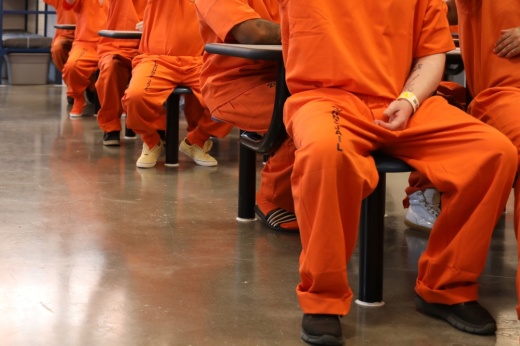Last year, the walls of the complex were pushed to their limits: the average daily population in the third quarter of 2022 rose above 10,000 people for the first time since 2011, according to the county’s jail population dashboard.
The Texas Commission on Jail Standards—the state agency responsible for enforcing minimum jail standards for construction, maintenance and operation—also found the jail out of compliance twice in the latter half of 2022: once Sept. 7 for keeping 64 inmates in temporary holding cells for longer than 48 hours, and again Dec. 19 for failing to provide an inmate insulin.
Jason Spencer, spokesperson for the Harris County Sheriff’s Office, confirmed the identity of that inmate as 28-year old Matthew Shelton, whose autopsy determined he died March 27 of diabetic ketoacidosis. Shelton was one of 27 people who died in Harris County in the custody of the HCSO last year, the highest number since 23 deaths in 2006, according to data from the Texas Justice Initiative, a nonprofit that collects and maintains criminal justice data.
County officials and a criminal justice advocate have offered varying explanations for the critical situation at the jail, including the backlog of criminal court cases exacerbated by Hurricane Harvey and the COVID-19 pandemic, with some citing a bill passed by the state Legislature in 2021.
“It’s not any one thing. The backlog of cases, the amount of time that people are spending in jail— ... people who are coming into jail are coming in frequently with pre-existing health conditions that haven’t been addressed out in society,” Spencer said.
But the county has helped lower the jail’s population before, and along with the hiring of a new head of detentions following the resignation of Shannon Herklotz on Jan. 9, officials could take further action this year.
‘Accountability ping-pong’
Brandon Wood, director of the Texas Commission on Jail Standards, said counties aim to keep their jails under 90% of their capacity because jail beds have certain classifications that make jail operations difficult above that level. The commission’s most recent report shows Harris County’s jail was at 91.36% of the total capacity on Aug. 1.
Spencer said a confluence of factors, including a rise in crime nationally during the pandemic, has contributed to the high jail population, but he believes each entity needs to evaluate where it could improve.
“The jail is where all of the snags in Harris County's criminal justice system ... manifest,” Spencer said. “[But] just like we bristle when other people tell us how to run our part of the jail, I’m not going to tell ... the district attorney how to run her shop ... [or] the judges how to start clearing the backlogs on their dockets,” he said. “The bottom line is, are we keeping everyone safe in the jail? 2022 was not a good year. ... We have to do better.”
In response to questions about the district attorney’s role in the size of the jail population, Communications Director Joe Stinebaker said in a statement that judges determine who is detained pending trial and who is not.
“Reducing the court backlog and clearing dockets has been and will remain a top priority for this office,” Stinebaker said.
Unlike a state prison, the Harris County Jail is filled mostly by people awaiting trial—80.5% of the jail population on April 1 was pretrial, the second-highest rate in the state behind Travis County, according to American Civil Liberties Union data. However, from 1998 until December 2007, the pretrial incarceration rate was below 50%, according to TCJS reports.Krishnaveni Gundu, executive director for the Texas Jail Project, a nonprofit organization advocating for jail reform, said in a statement she believes state and local policies have contributed to the growing pretrial percentage.
“Instead of investing in robust public health systems and housing—evidence-based solutions that reduce crime—we as a state have chosen to perpetrate punitive solutions that fail to address root causes of incarceration,” Gundu said.
Gundu said she believes the jail’s issues are the result of “accountability ping-pong” but also cited Senate Bill 6 as a reason for the rise in the jail population. The bill, passed by the Texas Legislature in 2021, bans cashless bail for people charged with a violent offense as well as those charged with committing a felony while out on bail or community supervision following a previous violent offense charge.
“Anecdotally from the people who work in the jail, ... they feel strongly that [SB 6] has had a significant impact on the population,” Spencer said.
The bill also mandates creating a public safety report for each person booked into the jail, which Gundu claimed has lengthened the booking process across the board.
In an analysis of processing times pre- and post-SB 6, the Harris County Office of Justice and Safety found the average processing time increased roughly 10% from April-December 2021 to April-December 2022 for incarcerated people not directly affected by SB 6.
A path forward
The county has had to address high jail populations before: the jail was over 90% capacity for much of 2005-09, TCJS data shows, peaking at 102% in October 2006.
According to archived agendas from the county clerk’s office, commissioners approved $9 million to outsource 600 inmates to Louisiana on Dec. 18, 2007, to lower the county jail population, but TCJS data shows the jail capacity was above 90% for most of 2008-09.
In addition, Precinct 2 Commissioner Adrian Garcia said at a January 2022 Commissioners Court meeting that when he became sheriff in 2009, his office created programs to allow inmates to build credit toward earlier releases and to keep people with mental health conditions out of jail.
However, he said he could do so because most people in the jail had been charged with low-risk offenses. As of Jan. 23, about 61% of the jail’s population had been charged with violent or serious crimes.
In terms of recent outsourcing efforts, commissioners approved close to $35 million in 2022 to send inmates to two private facilities in Louisiana and Post, Texas. However, at the July 19 meeting to approve the $25.75 million expenditure for Post, County Judge Lina Hidalgo described it as a “stopgap measure” needed to alleviate the impacts of the court case backlog.
As of October, commissioners had also approved nearly $40 million in federal American Rescue Plan Act funding since 2021 to tackle the court case backlog, according to the Office of County Administration. From the office’s Oct. 25 report to Commissioners Court, the backlog of felony cases was down 23% since Jan. 1, 2022.
County Administrator David Berry said at the July 19 meeting that using temporary federal funds and spending tens of millions of dollars a year to address the problem was “not financially sustainable.”
On Sept. 1, 2021, with support from Commissioners Court, the Texas Legislature created the 482nd District Court, the first new criminal district court in the county since 1984.
Even so, Megan LaVoie, the administrative director for the Texas Office of Court Administration, said during her Dec. 9 testimony before the Texas Senate Committee on Criminal Justice that based on case filings alone, the county would need 41 more district courts.
“It costs between [$500,000] and a million dollars to create a new district court, so there is a significant cost at the local level,” she said.
The Texas Legislature convened Jan. 10, but Wood said as of Jan. 6 that TCJS had not identified any bills that would help address jail populations.
“There’s always the potential for legislation that deals with criminal justice to have an impact on our jail populations,” Wood said. “It can range from increase[s] in penalt[ies], looking at the dollar amounts associated with the type of charges that can be filed [or] whether there’s any movement on the mental health side. All those things can definitely have an impact on the jail population. It’s still very early.”





